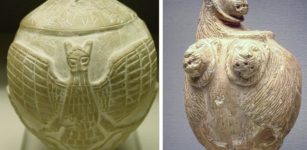Controversial Atacama Skeleton Is Not An Alien – DNA Study Reveals
AncientPages.com - In 2003, a tiny, mummified skeleton was discovered in the Atacama Desert behind a Church. It was so unusual that the discovery sparked international interest. The six-inch humanoid seemed to have an alien-like head and many people speculated it was of extraterrestrial origin.
Now, scientists from California have extracted DNA from the mummy’s bones and pieced together the real and tragic story of the individual, known as Ata.
The mummified skeleton of a baby girl found in the Chilean desert in 2003. Photograph: Dr Emery Smith
It appears that Ata was stillborn or died immediately after her birth, perhaps 40 years before her remains were discovered.
According to a study in published in Genome Research, the skeleton belonged to an infant girl with a handful of rare gene mutations linked to dwarfism, deformities and apparent premature aging.
“Experts have said previously the bones appeared to belong to someone between the ages of six and eight, but this advanced wear on the bones was likely a consequence of the child's deformities, not a reflection of her actual age, “ Daily Sabah reports.
Using DNA extracted from the bone marrow, researchers did a whole-genome analysis which determined that she was South American, "with genetic variations that identified her as being from the Andean region inhabited by the Chilean Chilote Indians," said the report.
The child had a never-before seen rib count of 10 pairs. Humans typically have 12 pairs.
Scientists state there is no evidence the skeleton is alien or ancient.
See also:
The Mysterious ‘Atacama Humanoid’ – One Of The World’s Most Baffling Skeletons
According senior author Garry Nolan, professor of microbiology and immunology at the Stanford University School of Medicine to a relatively short list of mutations in genes known previously to be associated with bone development" were found in genes related to dwarfism, scoliosis, and musculoskeletal abnormalities.
DNA extracted from the bones shows Ata was a girl who carried mutations in at least seven genes that are known to cause major skeletal malformations. Photograph: Dr Emery Smith
How the child was born with such genetic flaws is still a mystery, but researchers suggested contamination from a nearby mine could be to blame.
"While we can only speculate as to the cause for multiple mutations in Ata's genome, the specimen was found in La Noria, one of the Atacama Desert's many abandoned nitrate mining towns, which suggests a possible role for prenatal nitrate exposure leading to DNA damage," said the study.
"Nothing like this had been seen before. Certainly, nobody had looked into the genetics of it." For now, though, he urged the skeleton - which is owned by a Spanish archeological collector - to be returned to Chile.
I think it should be returned to the country of origin and buried according to the customs of the local people, Professor Nolan said.
AncientPages.com






















